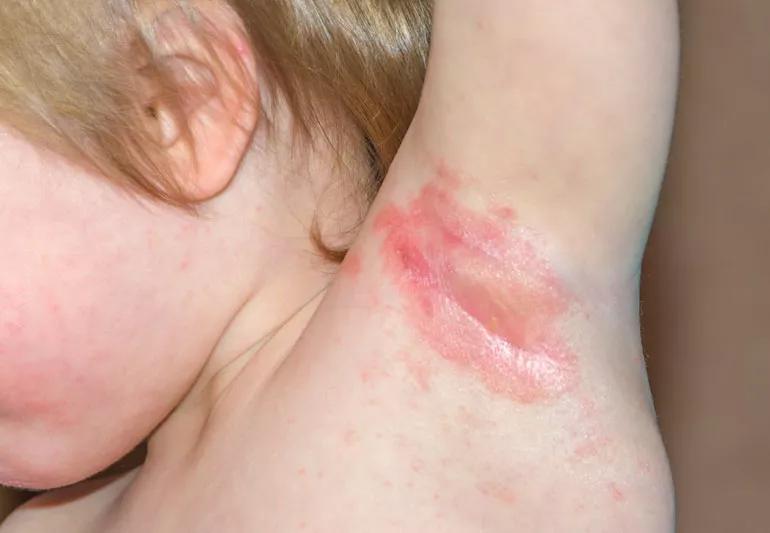Your face? Your armpits? Your butt? Yes, yeast infections can affect many parts of your body

You might think of yeast infections as a thing that only happens “down there,” but that’s not the case. Yeast loves moist, warm places, making several areas of your body perfect breeding grounds for the not-so-friendly fungus.
Advertisement
Cleveland Clinic is a non-profit academic medical center. Advertising on our site helps support our mission. We do not endorse non-Cleveland Clinic products or services. Policy
Everyone has small amounts of a yeast, or candida, on their skin and inside their digestive tracts. Healthy bacteria usually keep yeast from growing out of control. Yeast infections occur when these bacteria can’t do their job.
“If you’re sick and need antibiotics, the drugs can kill healthy bacteria, allowing yeast to thrive,” explains family physician Matthew Goldman, MD.
It doesn’t take much for these fungi to take over. “Not showering after a workout, or wearing tight-fitting clothing that holds moisture close to the body can lead to a yeast infection,” he continues.
Because yeast feeds on sugar, people who have diabetes and uncontrolled high blood sugar are more prone to these infections, too.
Yeast can make itself at home anywhere on your body, regardless of your age or sex. Here’s a closer look at where you can get a yeast infection:
Thrush is a yeast infection affecting the lining of the mouth, tongue and lips. It’s most common in infants. When babies have thrush, they usually develop white patches on their tongues and inner cheeks.
Adults — especially those who smoke, wear dentures, take antibiotics or steroids, or have weak immune systems — can also get yeast infections in their mouths. Symptoms of thrush look different in adults than in kids: Adults are more likely to have mouth sores that bleed, for example.
Advertisement
Thrush can also affect your throat and esophagus, making it painful to swallow. It’s also possible to get a yeast infection called angular cheilitis that causes tiny cracks in the corners of your mouth.
A side note for nursing parents: If you’re breastfeeding an infant with thrush, it’s important to know that your baby usually can’t pass their yeast infection on to you.
That may be surprising, based on what you see on the internet. Healthcare providers used to think nipple yeast infections — also known as “nipple thrush” — were a common occurrence. But recent research shows the condition is extremely rare, if it exists at all, and that transmission from infant to parent is equally unlikely. That’s important because it means that symptoms (like pain) that we used to associate with nipple yeast infections almost always have other causes.
Of course, absolutes are rare in medicine, and if you have a compromised immune system, fungal infections may affect your body in unique ways. As with all other nursing concerns, don’t hesitate to get in touch with your provider if something doesn’t feel right.
Oral antifungal medications are the standard treatment for thrush. You may need to swish the medication around in your mouth before swallowing it, or apply antifungal drops to your baby’s tongue.
Antifungal creams treat nipple yeast infections, but check with your healthcare provider to ensure the medicine is safe to use while nursing.
Hot temperatures, humidity and sun exposure can cause yeast on your skin to grow out of control.
Tinea versicolor is one example of a yeast infection that causes skin discoloration. Depending on your race or ethnicity, people with tinea versicolor may develop itchy brown, pink, red, white or yellow patches on their back, chest and belly.
You’re more likely to develop tinea versicolor if you have oily skin, sweat a lot or live in a tropical climate. These same risk factors can also cause a yeast infection on your face. Symptoms include a red, sometimes itchy and painful rash that resembles acne. You may also have dry, scaly patches that ooze pus. An itchy beard can be a sign of a skin yeast infection, too.
“Skin” is kind of a broad term. Depending on the specific part of the skin that’s infected, you may have to use a prescription antifungal cream, lotion, shampoo or soap.
“Tinea versicolor can come back, especially if you live someplace that’s hot and humid,” says Dr. Goldman. As a result, your healthcare provider may recommend using a prescription medicated cleanser once or twice a month to slow and manage yeast growth. You may also need oral antifungal medications.
Advertisement
We’ve already established that skin yeast infections (cutaneous candidiasis) can occur anywhere on your skin. That said, it’s particularly common in places where your skin rubs together. You may develop an itchy, inflamed rash:
People who have obesity or weak immune systems are more prone to an inflammatory skin condition called intertrigo, which often leads to yeast infections on their skin.
“The friction from skin rubbing together — combined with sweat trapped in skin creases — creates the perfect environment for fungi to multiply,” explains Dr. Goldman.
You can use topical antifungal creams, ointments or powders to treat yeast infections in skin folds.
If you want to lower your risk of this type of yeast infection, try applying drying powders or topical antiperspirants to the areas where your skin creases.
A scalp yeast infection causes an itchy, crusty rash and white flakes — symptoms that mimic dandruff or scalp psoriasis. You may also have fluid-filled pimples and hair loss.
You’re more likely to get a yeast infection on your scalp if you:
Advertisement
Antifungal shampoos, foams and ointments clear up scalp yeast infections. You can lower your risk of future infections by:
Fungal nail infections like onychomycosis cause toenails (and, less commonly, fingernails) to thicken, crack and turn yellow or brown. Your nail may even pull away from your nail bed, break into pieces and fall off.
Athlete’s foot is another fungal infection that causes an itchy, burning rash between your toes. It can also spread to the toenails and cause a fungal nail infection.
You can easily pick up the fungi that cause athlete’s foot by walking barefoot in contaminated moist areas like showers, swimming pools and gym locker rooms. You can also get it from sharing towels, shoes or clothing with someone who’s infected.
Fungal nail infections are difficult to treat and often come back. You may need to apply a topical antifungal cream and take daily oral antifungal medications for months. To lower the risk of a recurrence:
Advertisement
Yeast lives naturally inside the vagina, which is why vaginal yeast infections are so common. But yeast can grow uncontrollably on penises, too.
Penile yeast infections typically affect men who are uncircumcised. The fungi grow in the moist, warm area underneath the foreskin, causing painful swelling (balanitis) in the head of the penis. People who have obesity, diabetes or sexually transmitted infections (STIs) are most at risk.
Both types of genital yeast infections can cause burning, itching, white discharge and painful urination.
Over-the-counter antifungal creams are often effective for yeast infections in the genitals, but you should see a healthcare provider if the infection persists. You may need a stronger prescription antifungal cream or oral drug. It’s also possible that you have a sexually transmitted infection that requires a different treatment.
Not only can you pass a yeast infection on to a partner, but you can also spread the infection to other parts of your body. For that reason, it’s best to wait for your infection to clear up before having penetrative sex, receiving oral sex, using sex toys or masturbating.
Wearing diapers or absorbent underwear can cause yeast diaper rashes. They usually present as a raised, red rash with fluid-filled pimples around the genitals, thighs and butt cheeks.
Anal yeast infections occur when yeast that lives in your intestines travel to your anus. A genital yeast infection can also spread to your anus — and vice versa.
An intensely itchy bottom is often the first sign of an anal yeast infection. You may also have anal burning, bleeding, discharge or pain.
Not all diaper rash is the same, and the treatments vary. See a healthcare provider to determine the kind of rash it is. If it is a yeast infection, an antifungal cream should clear it right up.
Antifungal creams, ointments or suppositories are the go-to treatments for anal yeast infections.
While over-the-counter antifungal medications can effectively treat certain types of yeast infections, Dr. Goldman recommends seeing a healthcare provider to make sure fungi are the true cause of your symptoms.
“With proper treatment, yeast infections clear up within a few days or weeks,” he says. “Untreated, yeast infections can last for months. In rare instances, a yeast infection can seep into your bloodstream and cause a life-threatening infection like sepsis.”
You should also see your provider if yeast infections keep coming back after treatment. “A blood test may show why you’re more susceptible to yeast infections,” notes Dr. Goldman.
While most yeast infections tend to stay localized to one area of the body, it is possible for the fungal infection to spread. It’s important to keep the affected area clean and avoid scratching. Regular hand washing can also help prevent the yeast infection from spreading further. If you think your infection has spread, contact your healthcare provider.
As Dr. Goldman explains, it is possible for an untreated yeast infection to develop into what’s called invasive candidiasis. In these (rare) cases, the infection spreads to your bloodstream and, from there, to other parts of your body. It’s a life-threatening complication that’s usually seen in healthcare settings — in people who’ve been hospitalized and critically ill for a long time, who’ve recently had surgery, who have a medical device like a PICC line inserted in a vein, or who are severely immunocompromised. Outside of a healthcare setting, people with compromised immune systems and people who inject drugs run the highest risk of infection.
The symptoms of invasive candidiasis vary depending on where the infection has spread and may be masked by other serious illnesses. It’s diagnosed through a blood test.
It’s important to follow your provider’s treatment instructions. It’s especially important that you take the entire course of whatever medication your provider prescribes. Stopping a medicine before the yeast infection is gone or skipping treatments can lead to antifungal resistance. That’s when the fungi become immune to the medication’s effects, which allows the infection to grow and spread.
Dealing with fungi isn’t anyone’s idea of fun. With proper hygiene and treatments, you can keep the yeast that naturally live on and inside of your body at a healthy level.
Learn more about our editorial process.
Advertisement

Prescription and over-the-counter medications are the only safe and effective ways to treat a yeast infection

From baking soda to lemon juice, you probably have several home remedies in your fridge that can help with this fungal infection

The short answer from an obstetrician/gynecologist

If the area is bleeding a lot or the wound is near your face or genitals, you likely need a specialist’s care

Lots of things can activate the herpes simplex virus, from the common cold and cold weather to cracked skin and cosmetic procedures

Honey can help make a sore throat more bearable by tamping down inflammation and coating your throat

Internists see people 18 and over, while family medicine physicians can treat people of all ages — but from there, they have more similarities than differences

A combination of rest, fluids and over-the-counter medications can help you feel better fast

Babies can get congested easily, but you can calm their cough by keeping them hydrated, using nasal drops and running a humidifier

Weight loss may cause loose, sagging skin and muscle loss to your rear

Several conditions, like vitiligo and fungal infection, can cause a loss of pigmentation, leading to white spots or patches on your skin